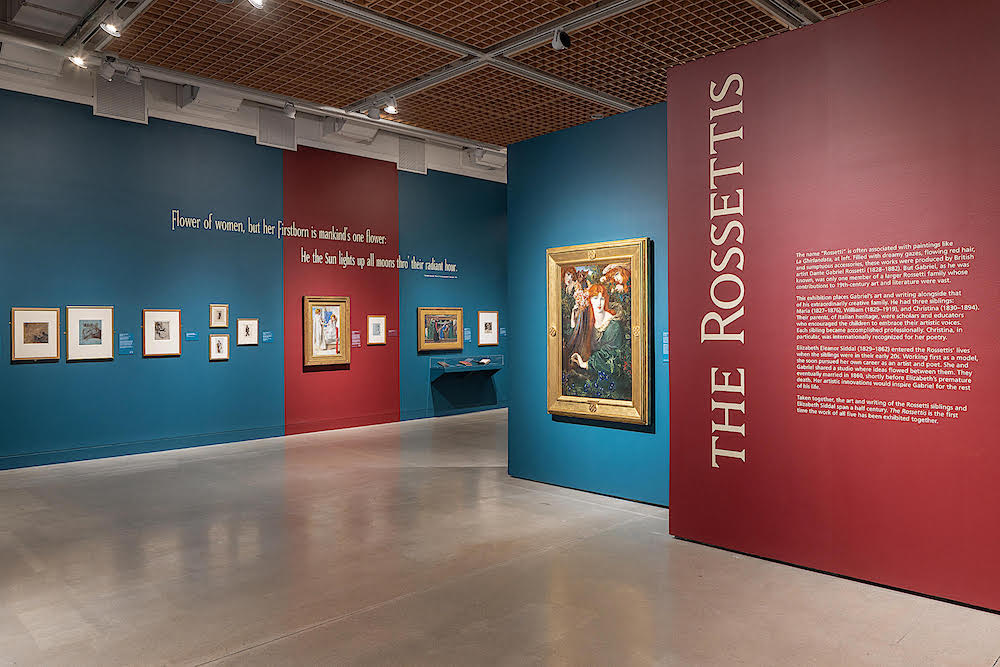
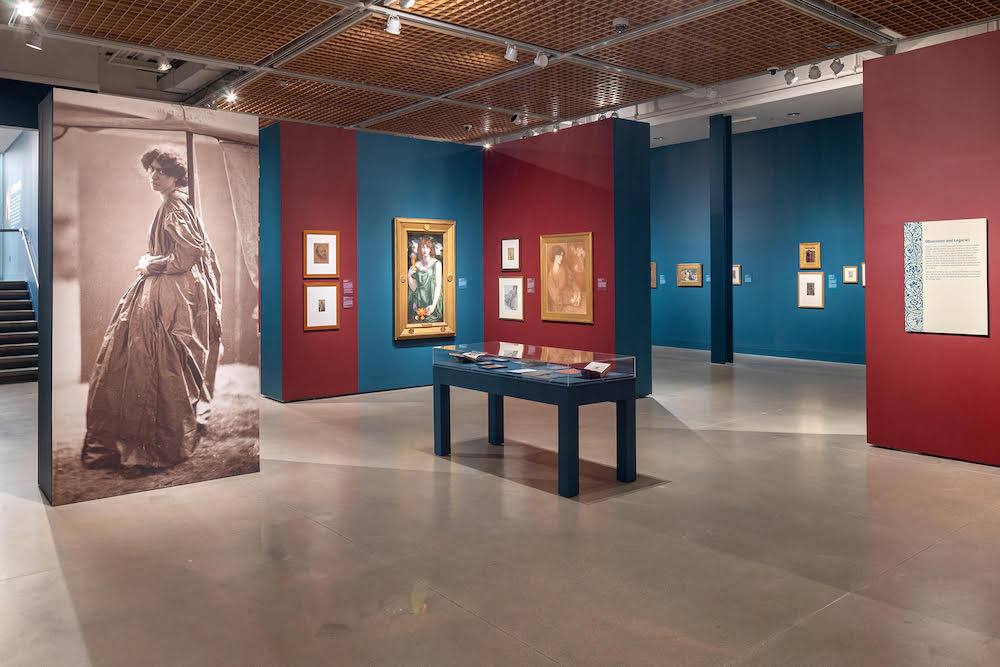
Installation photographs, all taken by Dan Jackson, and © Delaware Art Museum. Click on the images to enlarge them, and, in the case of the two works from our own website, to obtain more information about them.
This is the second venue for the exhibition previously held at the Tate Britain from 6 April–24 September 2023. The show opened in Delaware on October 20 2023 with a brilliant introductory lecture by Tate curator Carol Jacobi which explained the basic tenets of the exhibition. My wife and I later attended the “Pre-Raphaelite Weekend” organized by Sophie Lynford, the Annette Woolard-Provine Curator of the Bancroft Collection, and her colleagues, and held from November 9-11; the Pre-Raphaelite Musical Soirée that included a talk by Professor Tim Barringer from Yale, a well-respected Pre-Raphaelite scholar, kicked off the weekend. Other highlights included a visit to the Mark Samuels Lasner Collection at the University of Delaware and the opportunity to look behind the scenes in the library and archives with the show’s curator Sophie Lynford at some Pre-Raphaelite works on paper in Delaware’s collection.
I had previously seen The Rossettis at the Tate Britain when it opened in April 2023 and I always find it interesting to compare exhibitions shown at two different venues. This is particularly true when not every work travels to the second venue but often other works are then substituted in their place. In this case, both shows were brilliantly installed but there were significant variations between the two. The one in Delaware had to be reduced in scope to reflect the fact that, while the Tate had nine discrete rooms in which to exhibit, Delaware had only one large room with some movable walls. The Tate had multiple rooms for designers to work with and to paint the walls in various colours or cover in wallpaper. One room even reproduced a wallpaper that Rossetti had designed for the home that he and his wife shared at 14 Chatam Place in London. Delaware, however, limited their colour scheme to teal blue walls interspersed with sections of a deep rich red colour which was very effective.
I loved how the designers incorporated quotations from the poetry of Dante Gabriel or Christina Rossetti into their wall decorations. Despite space limitations Delaware still exhibited in excess of 150 objects, including paintings, drawings and watercolours, wood engravings, photographs of family, friends and models, books and bookbindings, and even rare manuscript poems. The show at Wilmington was enhanced by the inclusion of excellent labels, which would have been very helpful for those viewers not particularly familiar with the Rossetti family. None of the furniture designed or painted on by Rossetti that was shown at the Tate was included in this show. The Delaware show seemed more intimate than the Tate’s because of its compressed nature. One major advantage of seeing the show in Wilmington was the fact that, despite being well attended, one did not have to stand four deep in order to view a painting or drawing and could more easily study it up close. The absence of Ken Russell’s 1967 film Dante’s Inferno about the private life of D. G. Rossetti shown in one of the final rooms at the Tate was not missed in my opinion.
Delaware omitted the section from the Tate that showed Dante Gabriel Rossetti’s association with other members of the Pre-Raphaelite Brotherhood because of space considerations. The one great loss in this respect was the absence of Rossetti’s first major oil painting, The Girlhood of Mary Virgin of 1848-49, which was deemed too fragile to travel to Wilmington. One feature that did remain to remind visitors of Rossetti’s early connection to the Pre-Raphaelite Brotherhood was the etchings the group had done for The Germ, as well as copies of this early publication associated with the group to which Christina had contributed seven poems. Although the Delaware show focussed primarily on the artistic relationship between Dante Gabriel Rossetti and his wife Elizabeth Siddal, and these two were obviously the stars of the show, some attention was paid to Christina’s poetry. Unlike the Tate that had broadcast readings of Christina’s poetry in some of the rooms if you happened to step on a particular marked spot on the floor (which I personally found distracted me from concentrating on the art), Delaware offered one area to discretely listen to recordings to her poetry if one so chose. Emphasis was placed on perhaps Christina’s most famous poem Goblin Market, including the magnificent illustrations of the poem by her brother that she far preferred to the later ones by Laurence Housman. Unfortunately Christina’s pencil portrait of her brother William Michael, from the Cleveland Museum of Art, that was shown at the Tate was not shown in Wilmington. This drawing showed quite clearly that Christina herself was not without artistic abilities.
One area that was harshly criticized in the show at the Tate was that, by and large, William Michael and Maria Francesca Rossetti were given short shrift. In her display at Delaware, Sophie Lynford attempted to rectify this situation as much as possible within the scope of resources she had at hand. She added explanatory labels to Maria’s A Shadow of Dante and William’s The Comedy of Dante Alighieri, whereas there had been none at the Tate. In particular, she noted that siblings had designed the book bindings for both books: Maria’s was designed by William, and William’s by Gabriel. This served to emphasize the way the siblings’ collaborations extended beyond William and Christina posing for Gabriel, and Gabriel illustrating Christina’s poems. Numerous photographs of William, Christina, Maria, Frances, and Gabriele were added, none of which had been in the Tate’s show. The loans of books, letters, and family photographs mainly came from the Helen Farr Sloan Library and Archives of the Delaware Museum, or were lent by the Mark Samuels Lasner collection.
William certainly emerged more prominently here. The material on him, generally located in cases, included his Life of John Keats, his edited volume of Walt Whitman’s poems, and his first publication of anthologized art criticism, Fine art, chiefly contemporary: notices reprinted, with revisions from 1867. These brought out his important contributions to the world of art criticism and literature. In order to demonstrate his political radicalism two copies of his Democratic Sonnets were also included in the final case in the show. William’s vital role as the primary historian of the family and the Pre-Raphaelite Brotherhood included his 1896 edited volume of New Poems by Christina Rossetti: Hitherto Unpublished or Uncollected; the 1899 first edition of Ruskin, Rossetti, Pre Raphaelitism: Papers 1854 to 1862; and the 1901 edition of Gabriele Rossetti: A Versified Autobiography. Unfortunately, however, William’s artistic achievements were still largely ignored. He had received some artistic training early in his career but this aspect of his output was only shown by two early sketches, accomplished copies of the work of his drawing master John Sell Cotman from his schooldays at King’s College School in London. It is a pity that none of his later drawings were included, particularly those he did of his family or his fellow members of the Pre-Raphaelite Brotherhood, such as were illustrated in Angela Thirwell’s book on him.
Both the Tate show and the Delaware show provided convincing evidence of the cross-influences in the works of Gabriel and Lizzie. This for me was the most important scholarly impact of the show and one that broke new ground from previous Rossetti exhibitions. For many years scholars assumed that Rossetti was the sun while Lizzie was the moon, as shown in Gabriel’s Dantis Amor of 1860, with Lizzie’s work considered largely derivative of her husband's.

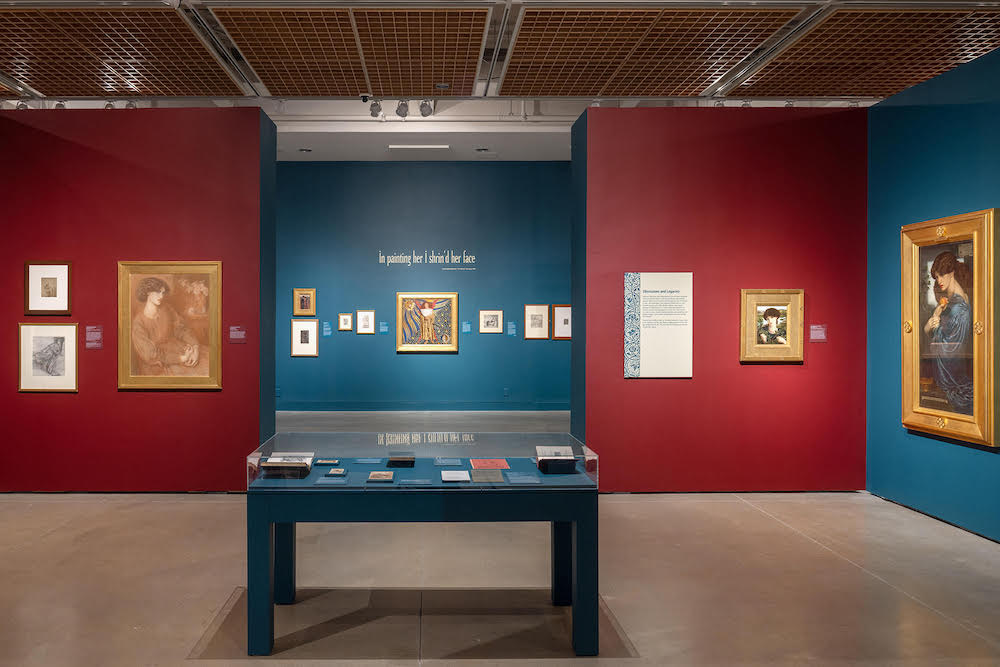
Left: Rossetti's Dantis Amor. Right: The painting as shown in the exhibition.
Scholars had tended to downplay Rossetti’s comments in his letter to Ford Madox Brown of 23 May 1854 that "Her power of designing even increases greatly, and her fecundity of invention and facility are quite wonderful, much greater than mine." The curators convincingly showed that the influences were not simply in one direction and that Lizzie’s compositions in many instances had a definite effect on Gabriel’s subsequent work. Rossetti at times took ideas initially conceived by Siddal and incorporated them into his own work. The delineation of these cross influences definitely made the exhibition well worth seeing, even if for no other reason. The concept that “ideas flowed both ways in the working relationship” is expertly covered in Glenda Youde’s chapter “Dante Gabriel and Elizabeth Eleanor Rossetti: The Artistic Partnership” in the exhibition catalogue. One of the most interesting works on display was Sir Galahad and the Quest for the Holy Grail of 1855-57 from Wightwick Manor, that was a joint production between Rossetti and Siddal.

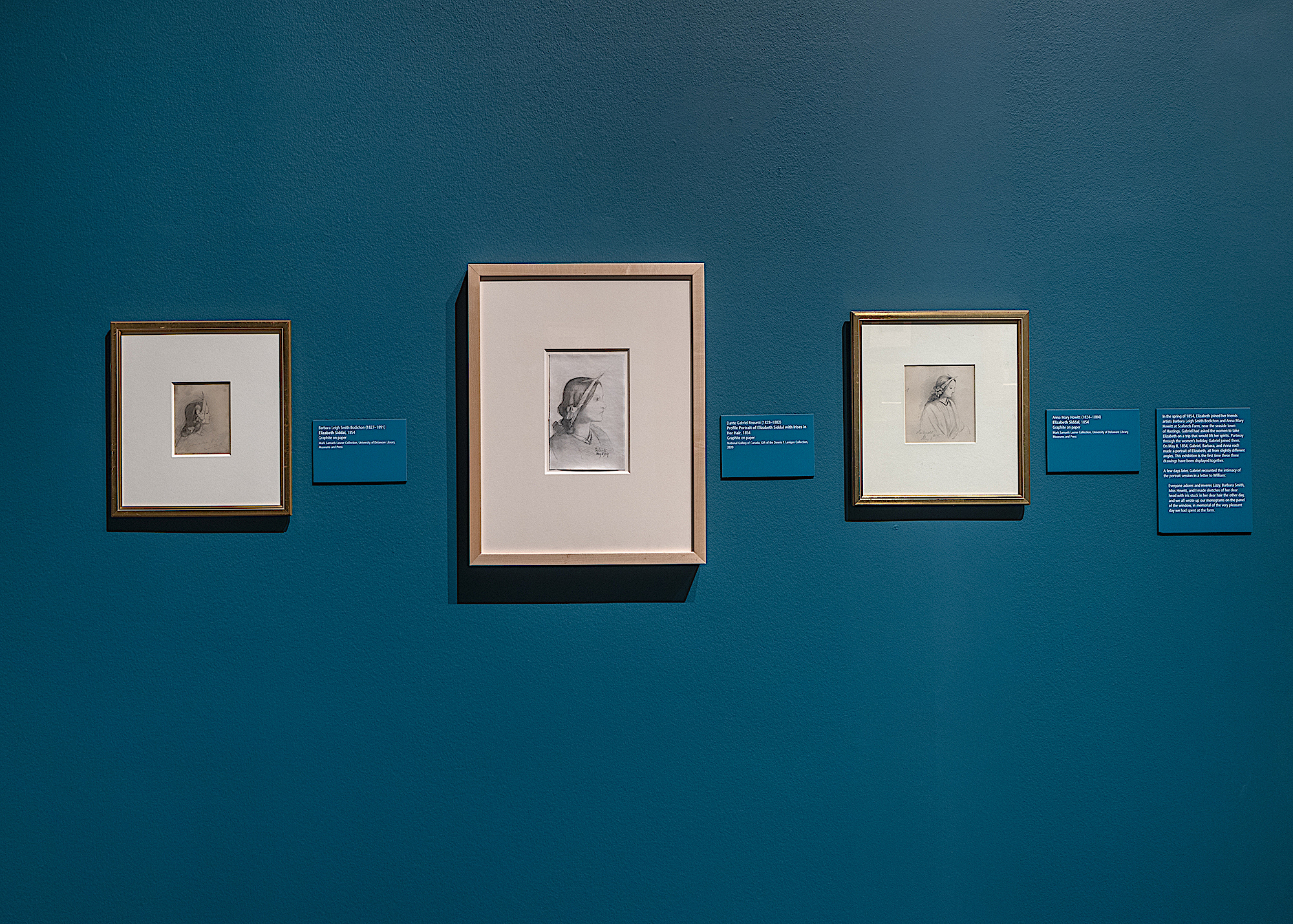
Left: Sir Galahad and the Quest for the Holy Grail, 1855-57. Right: Dante Gabriel Rossetti, Barbara Leigh Smith, and Anna Mary Howitt. Three images of Lizzie Siddal from Scalands, 1854.
For me one of the highlights of the entire exhibition was seeing the three portraits of Lizzie done at Scalands on 5 May 1854 By Rossetti, Barbara Leigh Smith, and Anna Mary Howitt. To see these three portraits reunited has long been a dream of mine and this is probably the first time the trio have been shown together since they left Leigh Smith’s possession. At the Tate show the Rossetti drawing had been represented by a facsimile, one of many important drawings represented by facsimiles in that show. Facsimiles were used either because the Tate could not afford transportation costs for the originals, or institutions like the Birmingham Museum and Art Gallery were unable to lend. Fortunately no facsimiles were included in the Delaware show.
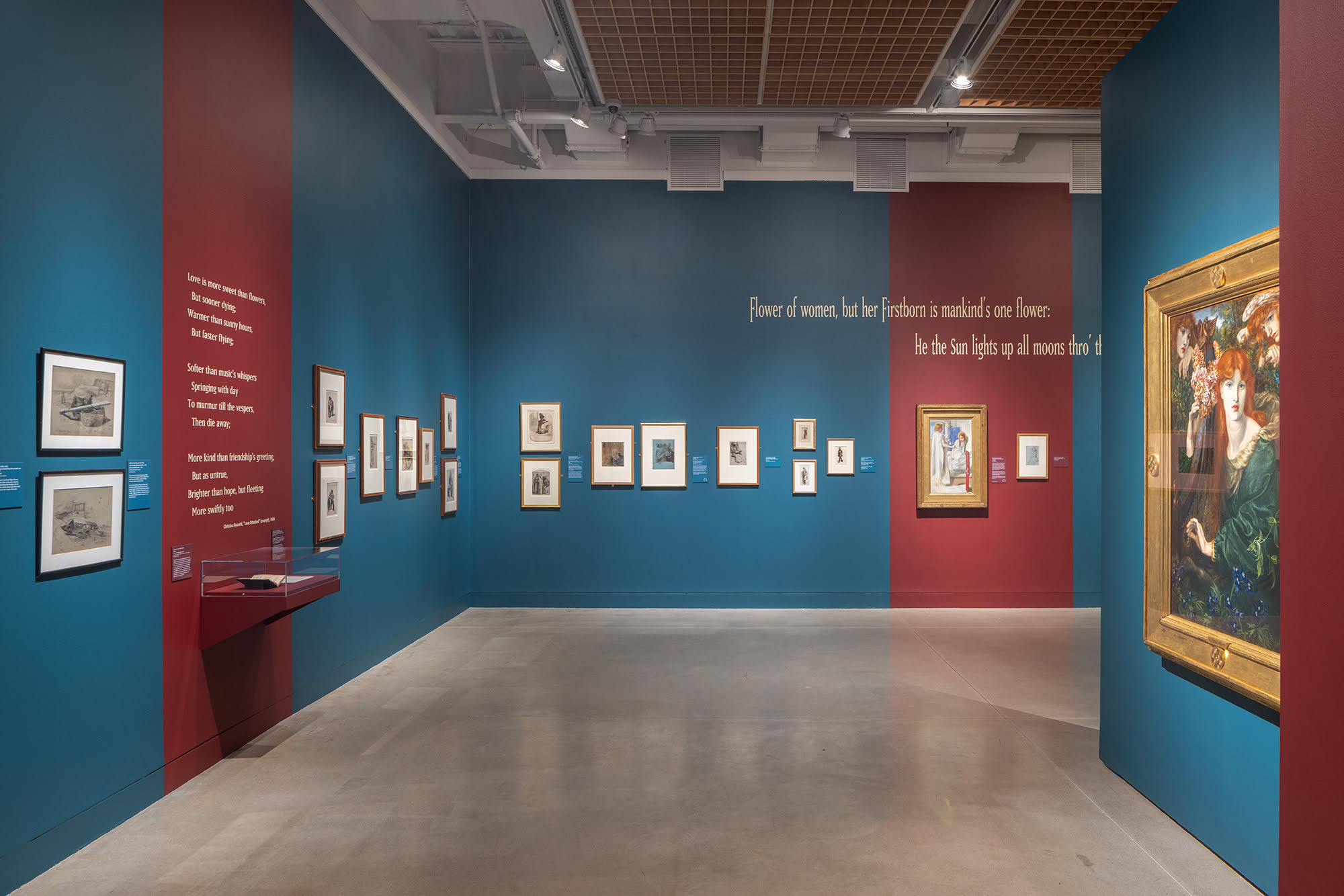
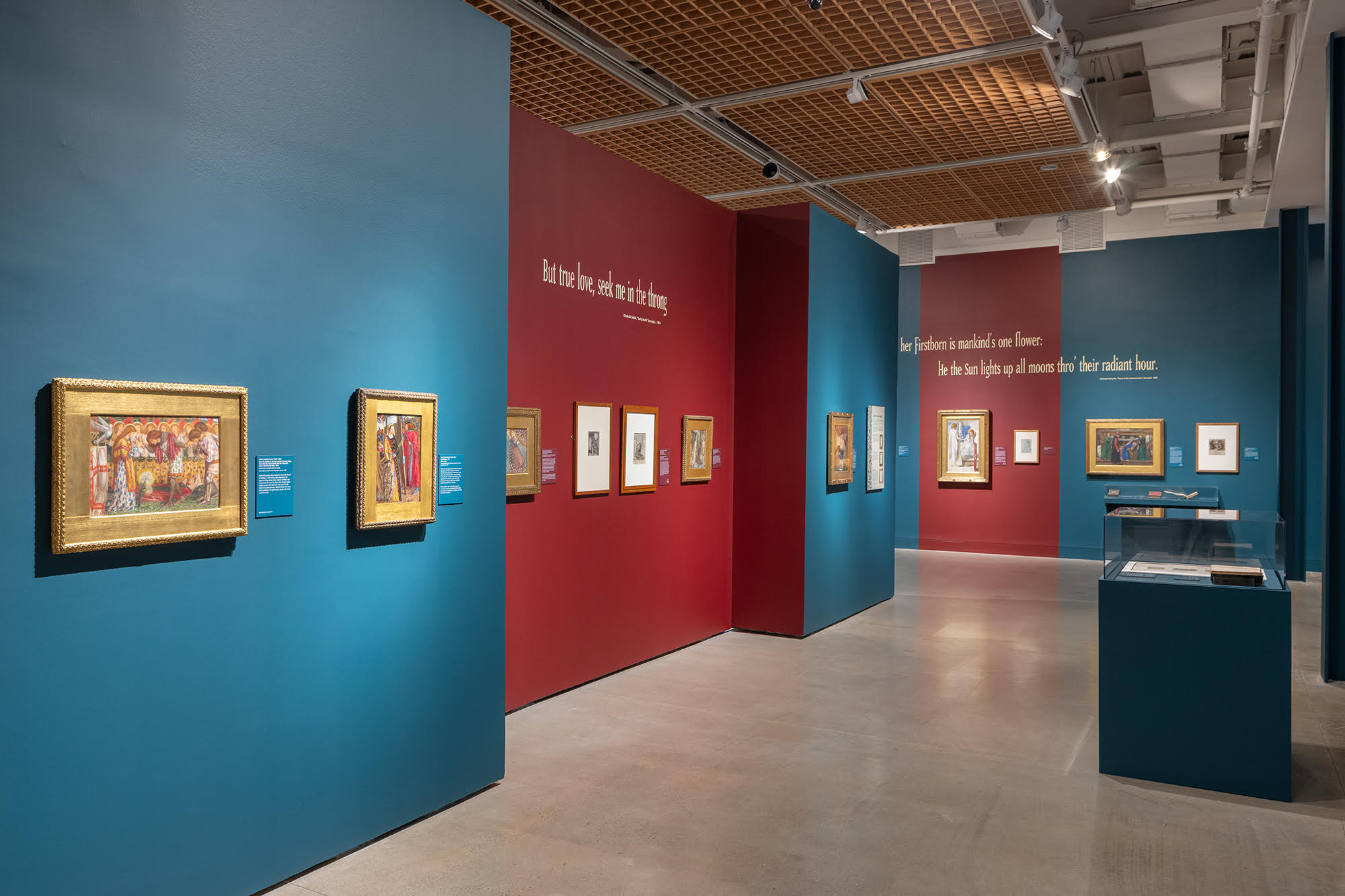
Left: Rossetti's early drawings. Right: Rossetti's early watercolours.
The introductory aspect of the exhibition focused on D. G. Rossetti’s early drawings before the formation of the Pre-Raphaelite Brotherhood with themes particularly taken from Goethe’s Faust and the tales of Edgar Allen Poe, especially his poem The Raven. Rossetti’s early watercolours of the 1850s were well represented including works like Dante’s Dream at the Time of the Death of Beatrice, The Tune of the Seven Towers, Paolo and Francesca, and Arthur’s Tomb. One masterpiece that sadly did not travel to Delaware was The First Anniversary of the Death of Beatrice of 1853 from the Ashmolean Museum in Oxford although the subject was represented by a pen-and-ink drawing. Although Siddal was well represented by her drawings and watercolours, three of her greatest watercolours, Sir Patrick Spens from the Tate, Clerk Saunders from the Fitzwilliam, and Lady Clare from a private collection, were not included in the Delaware show. The principal reason for this, of course, is concern regarding conservation. For those that love in particular the early watercolours by Rossetti from the Tate Britain this is a special incentive to see the exhibition at Delaware. Because of the long run of the shows at London and Wilmington the Tate plans to put these light sensitive works in storage for a period of ten years before considering exhibiting them again.
Conservation concerns were less of a problem when considering which oil paintings could be sent to Delaware. Fortunately most of the oils that did not come to Wilmington could be compensated for by adding works from Delaware’s own collection that had not been borrowed by the Tate for their show. A number of important works did not make the journey to America but one work that was especially missed was Boca Baciata from the Boston Museum of Fine Arts because of its historical importance. This was the first of Rosssetti’s half-length portraits of beautiful women influenced by Venetian High Renaissance painting and a major landmark in the development of the nascent Aesthetic Movement. The show contained many of Rossetti’s most famous oil paintings of “stunners,” featuring his principal models Fanny Cornforth, Jane Morris, and Alexa Wilding. Works such as The Beloved, Monna Vanna, Proserpine, La Ghirlandata, Lady Lilith, and Veronica Veronese must surely rank amongst Rossetti’s greatest masterpieces. The oils were often hung with interesting companion works hanging next to them. Rossetti’s early Ecce Ancilla Domini, for instance, had the pencil study for the Virgin Mary right adjacent to it unlike at the Tate. In both of Rossetti’s early oil paintings dealing with the life of the Virgin Mary his sister Christina was the model for Mary. As at the Tate it was wonderful to see Rossetti’s Found, his only work of social realism, surrounded by the many studies for it.
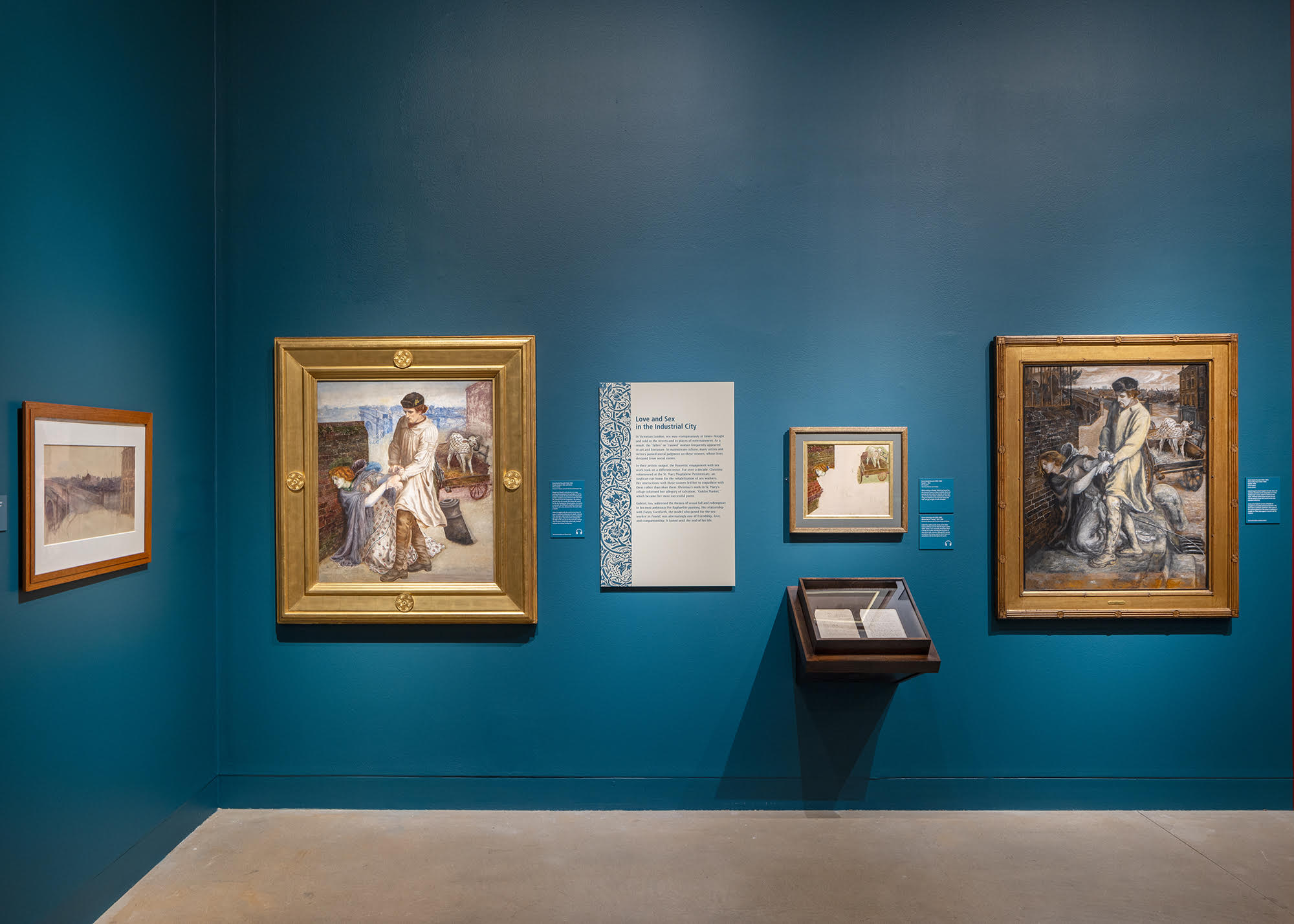
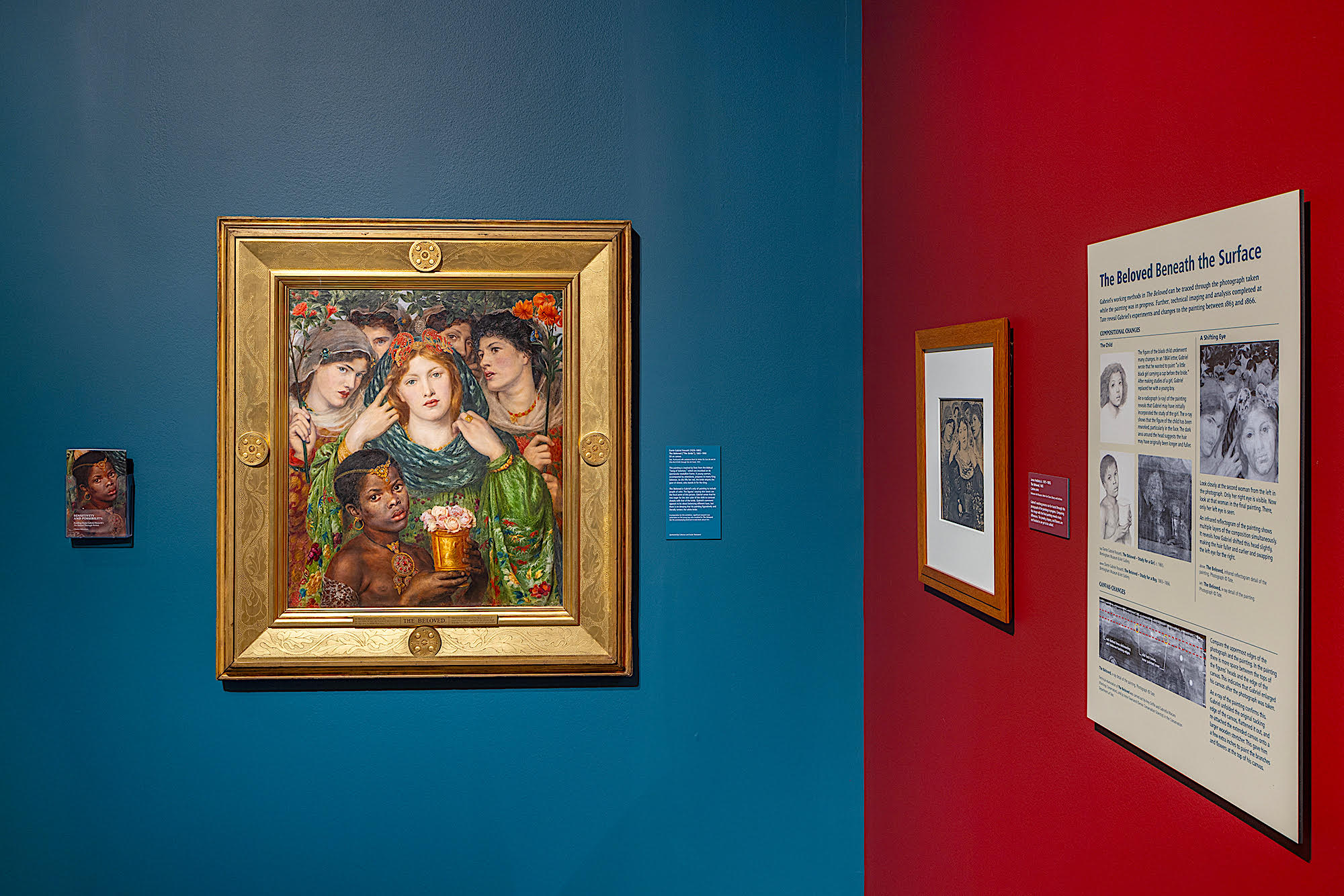
Left: Rossetti's Found and his studies for it. Right: Rossetti's The Beloved, fully contextualised.
I was left wondering, however, why Rossetti was never able to bring this work to completion when his much less talented studio assistant H. T. Dunn was able to complete the composition in one of his oil studies for the picture from the 1870s. I also liked the information panel hanging in the gallery that described the types of frames Rossetti had designed during his career.
The Beloved has always been one of my favourite works by Rossetti so I was pleased to see it singled out for special treatment. It was a treat to see the technical analysis conservators had done on this work, including an x-ray image of the painting in its current state, in order to document changes made during the course of work on the painting. This was supplemented by a photograph from March 1865 by James Hedderly showing the state of the painting at this time. Both these studies clearly showed that Rossetti had changed the figure in the background to the left in the composition to show her left eye rather than the right. As well Rossetti had initially painted a young black girl rather than a boy in the foreground. Apparently it was not uncommon for Rossetti to bring in a photographer to his studio to document the progress of his oil paintings. The Beloved also had drawings of various figures who had posed for the picture hung nearby.
For individuals interested in the Pre-Raphaelites this show is not to be missed because it offers viewers in North America the rare opportunity to become familiar with the Rossetti family, particularly with the work of Dante Gabriel Rossetti and his wife Elizabeth Siddal. The exhibition includes not only works from public collections but also from private collections — works which otherwise would be rarely seen. Christina Rossetti fares the best of the remainder of the Rossetti siblings while the careers and accomplishments of William Michael and Maria are barely touched upon. For those who unfortunately are unable to visit the exhibition in person a catalogue published by the Tate Britain with essays by various scholars is available and is well worth having.
Bibliography
Jacobi, Carol, and James Finch Eds. The Rossettis. London: Tate Publishing, 2023.
Thirwell, Angela. William and Lucy. The Other Rossettis. New Haven & London: Yale University Press, 2003, 108-15.
Created 27 November 2023